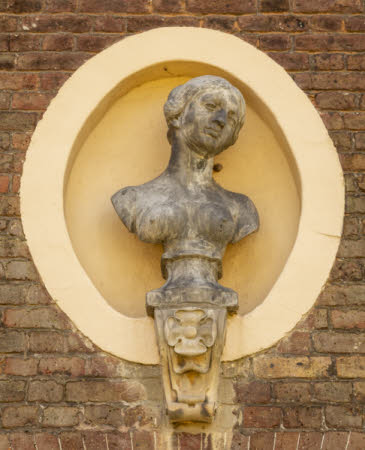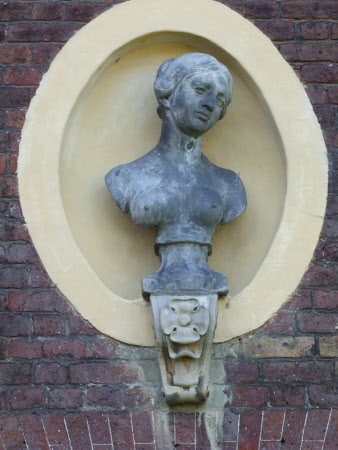Portrait bust of a woman
workshop of John Besnier (fl.1681)
Category
Art / Sculpture
Date
c. 1670 - 1672
Materials
Lead, Sandstone
Place of origin
London
Order this imageCollection
Ham House, Surrey
NT 1140357
Summary
A lead portrait bust of a woman, naked and with her breasts exposed. The head is derived from a famous statue of Saint Susanna by the Italo-Flemish sculptor François Duquesnoy (1597-1643). One of thirty-eight lead busts made for the garden walls of Ham House in 1671-72, perhaps in the workshop of John Besnier, thirty-six of which survive in niches on the walls and on the north façade of the house.
Full description
A lead portrait bust of a woman, shown naked and with her breasts exposed. Her hair is parted at the middle and gathered up at the sides, and her head is tilted to her left and downwards. Mounted on a plinth, and placed on a sandstone console decorated with a four-petalled rosette, with below scrolling tongues. One of thirty-six lead busts displayed in oval niches in the garden walls and on the north façade of Ham House, probably installed in 1671-72, and recorded in the 1679 inventory of Ham House. The entire series was probably arranged in its present positions along the garden walls and on the north front of Ham House by the 6th Earl of Dysart as part of improvements undertaken between 1798 and 1803. The busts may well, like other sculpture at Ham House, have been made in the workshops of the Besnier family, perhaps by John Besnier, who received a commission for lead statuary from the Duke of Ormonde in 1681. For a fuller discussion of the garden wall busts and their history and attribution, see NT 1140333. The bust is one of a series of female busts now displayed on the north front of Ham House, several of which are clearly based on modern sculptures rather than Roman prototypes. Charles Avery recognised that the model for this bust must in fact have been what, at the time of its making, would have been regarded as one of the most famous modern sculptures, François Duquesnoy’s marble standing figure of Saint Susanna in the Roman church of Santa Maria di Loreto, made between 1629-33 (Marion Boudon-Machuel, François du Quesnoy, 1597-1643, Paris 2005, cat. 34.). The marble sculpture, which depicts the saint as a statuesque and heavily robed standing figure, was not well-known beyond Rome before the eighteenth century. However, knowledge of the sculpture was disseminated through small bronze busts of the upper part of the saint’s body, a large number of which survive (Boudon-Machuel, cat. 35). It would seem probable that one of these small bronze busts was the model for the Ham House bust in which, disconcertingly, the modestly clothed holy woman is transformed into a naked figure. Jeremy Warren January 2022
Provenance
Probably made and installed in 1671-72, to the commission of John Maitland and Elizabeth Murray, 1st Duke and Duchess of Lauderdale. Thence by descent,until acquired in 1948 by HM Government when Sir Lyonel, 4th Bt (1854 – 1952) and Sir Cecil Tollemache, 5th Bt (1886 – 1969) presented Ham House to the National Trust. Entrusted to the care of the Victoria & Albert Museum until 1990, when returned to the care of the National Trust, to which ownership was transferred in 2002.
Makers and roles
workshop of John Besnier (fl.1681), sculptor after François Duquesnoy (Brussels 1594 - Livorno 1643), sculptor
References
Avery 2013: Charles Avery, ‘Seventeenth-century Sculpture at Ham House’ in Christopher Rowell, ed., Ham House. 400 Years of History, New Haven/London 2013, pp. 158-77., pp. 172-76, fig. 162 (NT 1140359 incorrectly illustrated).

